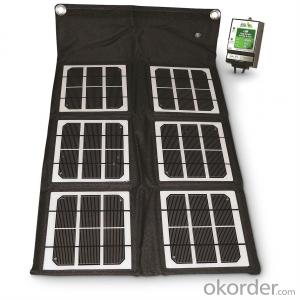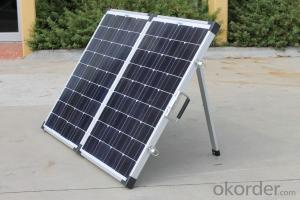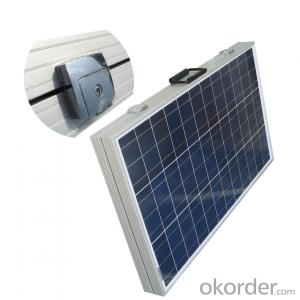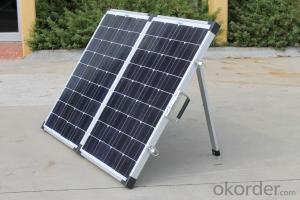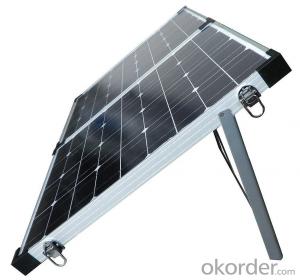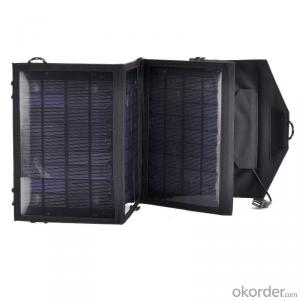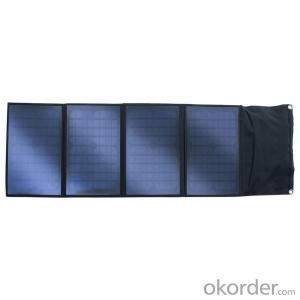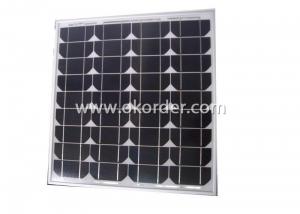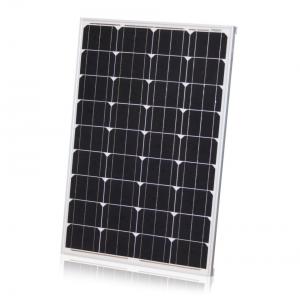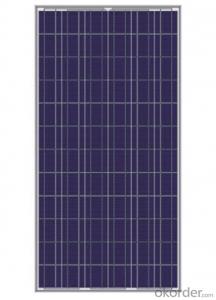Sun Electronics - 110W Folding Solar Panel with Flexible Supporting Legs for Camping
- Loading Port:
- Shanghai
- Payment Terms:
- TT OR LC
- Min Order Qty:
- 1000 watt
- Supply Capability:
- 10000 watt/month
OKorder Service Pledge
OKorder Financial Service
You Might Also Like
Specification
Product Description
Folding module kits are designed to provide portable 12 volt power wherever you need it.PoPwer available from 20W to 240W
Features:
· Padded, moulded carry bag
· Heavy duty carry handle, hinges and clasps Stainless steel telescopic&adjustable legs
· Weatherproof solar charge controller with LED indicator
· 5m cable with heavy duty Anderson connectors between module-regulator & regulator-battery clamps
· All cabled up ready to use
· 2 year warranty
These kits are the ideal solution for 4WD, camping, caravaning, boating and recreational activities whereverpower is required for lights, small TV, camping fridge, pump or other small appliances.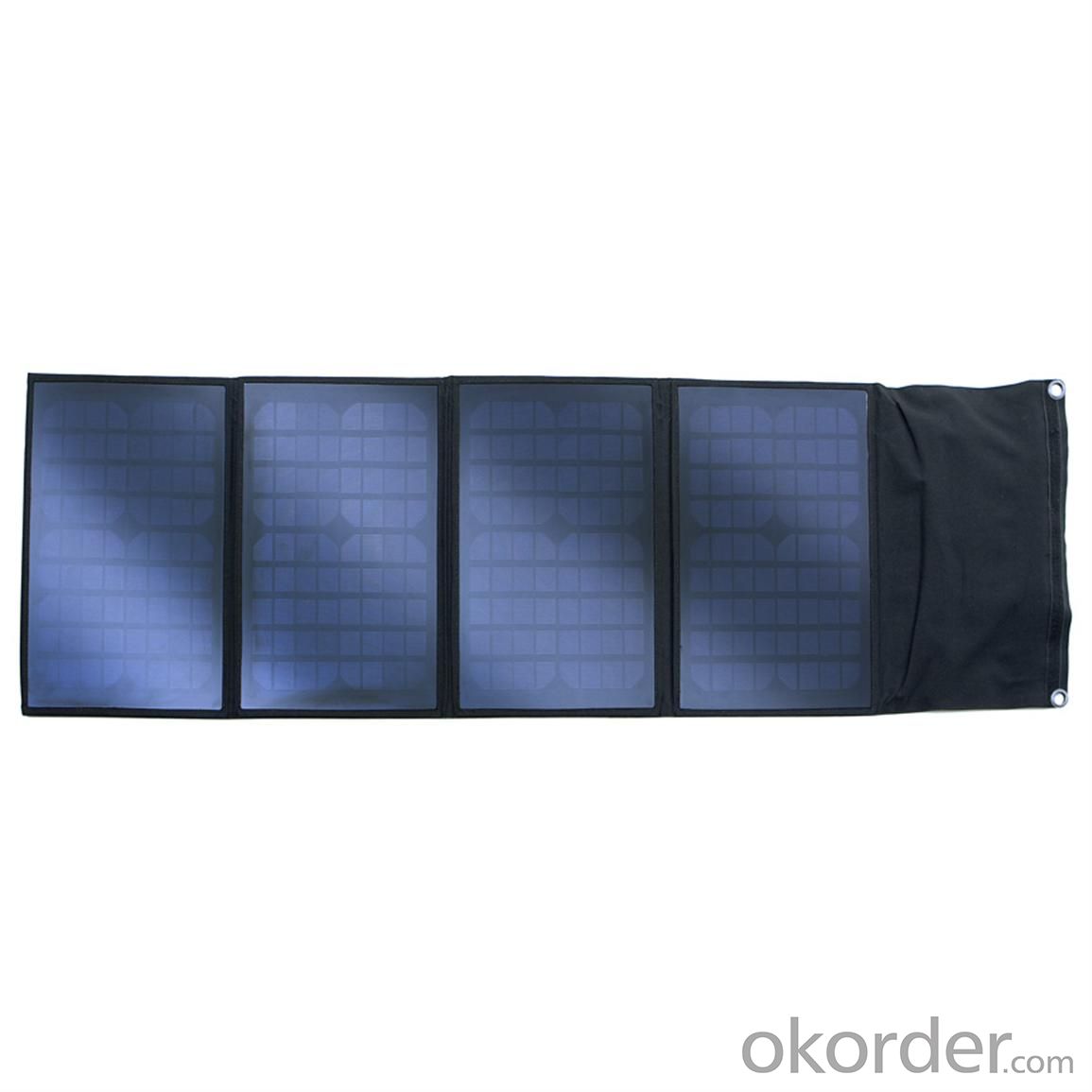
| Nominal Peak Power | 110W | 120W (2 x 60W) | 160W (2 x 80W) | 200W (2 x 100W) |
| Power tolerance | 3% | |||
| Cell type | Monocrystalline/Polycrystalline | |||
| Open circuit voltage (Voc) | 21.6V | |||
| Voltage at maximum power (Vmp) | 17.6V | 17.5V | 17.5V | 17.5V |
| Short circuit current (Isc) | 4.9A | 7.4A | 9.88A | 12.34A |
| Current at maximum power (Imp) | 4.54A | 6.86A | 9.14A | 11.42A |
| Maximum system voltage | 1000VDC | |||
| NOCT (Nominal Operating Cell Temperature) | 45 C +/-2 C | |||
| Operating temperature - module | -40 C to +85 C | |||
| Operating temperature – charge | -35 C to +55 C | |||
| Module folded size (mm) in carry bag | 505x550x60 | 505x825x80 | 505x1005x70 | 670x1005x70 |
| Module open size (mm) | 1014x550x30 | 1014x825x35 | 1014x1005x35 | 1344x1005x35 |
| Module net weight (kg) | 9.2 | 13 | 15.2 | 19 |
| Module gross weight (kg) | 11 | 16 | 19.4 | 23.2 |
| Solar charge controller | PWM 12V 10A; IP65 rated | PWM 12V 20A; IP65 rated | ||
- Q: How do solar panels reduce carbon emissions?
- Solar panels reduce carbon emissions by harnessing the power of the sun to generate electricity. Unlike traditional energy sources such as coal or natural gas, solar energy does not produce any greenhouse gases when converted into electricity. By utilizing solar panels to generate power, we can reduce our reliance on fossil fuels and significantly decrease carbon emissions, contributing to the fight against climate change.
- Q: i was looking into making solar panels to reduce my electric bill, but i need to know how to actually hook it up.
- most of the listings are there to get you to send 'em money. some promise a refund if they don't work. good luck getting your money back. it's not going to happen. last, the inverter, and control to feed power back into the grid are expensive. the utility gets to control what you can use, and most often you have to buy it from them. in Calif, the utility has an interest in good solar installations. they provide power during the time of peak demand, so the utility does not have to build/buy the last, most expensive kilowatt. however, (A) any installation that will be at all useful is large, and expensive, and (B) as with all electronics, next year will be better. i'll probably do it. but not yet.
- Q: Can solar panels be used for powering a manufacturing facility?
- Yes, solar panels can be used to power a manufacturing facility. Solar energy can be converted into electricity, which can then be used to power various processes and equipment in a manufacturing facility. This can help reduce reliance on traditional energy sources and promote sustainability. However, the feasibility and capacity of solar power for a manufacturing facility would depend on factors such as the facility's energy requirements, available space for solar panel installation, and local sunlight conditions.
- Q: I'm looking at solar panels and I have NO IDEA what this stuff means.They come in catagories of Watts. What does that refer to? If a solar pannel is in the 200-watt catagory, what does that really mean? Will it produce 200 watts an hour, a day, a week, a month, a year?? How many watts of energy does the average house use up in one month? I really wish they would just tell me on the website!! :(0 points!!!!!!!! :D
- Watts is a measurement of power which is a combination of Voltage x Amps Example: a 200 Watt panel can produce 6.6 amps at 2 Volts. (200 = 2 x 6.6) If you bought a 24 volt system the same 200 Watts would give you half the amount of amps since the power (watts) is the same. When determining your needs for a solar system there are many factors that have to be taken into account. The amount of power you use will depend on what appliances you have in the house, how much you use them, and how careful you are with vampire loads (A TV or stereo will use some power even when turned off unless you unplug them). The amount of panels you need will also depend on your battery system, amount of sunlight that you have in a day and how many days of reserve power you think you will need based on the weather in your area. If you wanted to completely run your house on solar energy you are looking at an investment of $5,000 - $20,000 or even more. There sometimes are tax incentive depending on where you live that will reduce your overall cost. Some examples of power usage: Toaster : 800-500W Microwave : 600-500W Dishwasher : 200-500W Washing Machine : 500W Vacuum Cleaner : 200-700W Iron : 000W Clothes dryer : 4000W Ceiling Fan : 0-50W Table Fan : 0-25W Electric Blanket : 200W Hair Blow dryer : 000W Electric Shaver : 5W Laptop Computer : 20-50W Desktop Computer : 80-50W TV (9 colour) : 70W Clock radio : W Fridge / Freezer : 500W 25 colour TV : 50W Electric Kettle : 2000W
- Q: I have an electric bicycle that I travel to work by, pulling a modified child carrying trailer that holds two 2 volt deep cycle batteries in series to power the 24 volt bike motor. I'm thinking about adding a 50 watt solar panel (or larger depending on the room I can make available) to charge while I'm at work and to provide some extra juice while on my more distant travels.Can I get a solar panel to charge them while they're connected the way they are: in series? Does charging work that way?I've read that in order to charge the 24 volt battery setup (if the answer to the Q above is yes), the output from my solar panel would need to be a little more than 24 volts. Is this true? If so, how many volts?Since the bike is supposed to be powered at 24 volts and I have an x-volt (x gt; 24v) solar panel connected to it, will this cause any damage to the controller or other components while running them?Will it help supply power even while the motor is being run?Thanks.
- The important part of the long answer is the charge controller - those batteries cost way too much to cook them out. And the controller maker will specify how much voltage your panels need to supply (more than 24 certainly) to provide a charge for several hours a day so you aren't wasting money on something that actually does very little. I also hope you have a very secure location to store this rig at work because while a bike with a tow trailer is easy to disguise and awkward to move, as soon as you put a solar panel on it, it becomes a very obvious theft target and maybe a vandalism target. And since you want to charge at work, it has to be outside. And since for effective use the panel has to mostly face the sun but you don't want to drag it broadside through the air while riding, you will have to either work out a pivoting mount or angle the whole trailer to the general position of the sun when parked and have the panel flat on top. I personally would probably redesign so that at work the trailer pulled up along side the bike and was chained/locked to it to make a really awkward mass that had the panel bolted through the lid with blind bolts.
- Q: I have purchased a 2 volt LED lantern from argos, it comes with a built in 6 volt 4ah sealed acid battery. What I wanted to know is would I be able to charge it using my 6 volt solar panel?
- If it has a 6 volt battery- is it marked 2 volts on an external plug? If so, there is a resistor inside to drop the potential the battery sees. The battery itself could be slipped out and recharged easily from your 6 volt panel. Just determine how much current (in Amps or Milliamps) the panel produces nominally and divide that into 4 and add one fourth of that length of time to make up for system losses. This will tell you how many hours it should charge assuming your starting voltage of the battery is above .5 volts. and the panel is at 3 volts potential or higher. So if your panel puts out amp at 0AM, you would charge for 5 hours. 4 divided by is 4 and one fourth of that is so 4 plus is 5. It is a little more involved than that, but as a rule of thumb. Also do not discharge tha lantern to the point of no light output. LEDs are efficient, but their current will add up. If it is suggest to be able to use the lantern for up to 8 hours on a charge, stick to that value. Lead acid batteries have best longevity when discharged only to 80 percent capacity. Once battery is charged- disconnect from charging source.
- Q: Can solar panels be installed on a fire station or emergency services building?
- Yes, solar panels can be installed on a fire station or emergency services building. In fact, many fire stations and emergency services buildings have embraced solar energy as a sustainable and cost-effective solution for their power needs. Solar panels can be installed on rooftops, parking lots, or open spaces surrounding these buildings to harness solar energy and generate electricity. This helps reduce their reliance on traditional energy sources, lowers operating costs, and contributes to a cleaner and greener environment.
- Q: Can solar panels be used in areas with high levels of radiofrequency interference?
- Yes, solar panels can be used in areas with high levels of radiofrequency interference. However, it is important to ensure proper grounding and shielding measures are in place to minimize the impact of radiofrequency interference on the performance of the solar panels.
- Q: lately i have been interested in solar power. i own my own home and in Texas it's HOT, so my A/C is always on and that light bill is like $300.00 a month. i was looking at other light companies but then i remembered that there are the so called solar power but i dont knowknow to start or how it would work to power the a/c machine...pls help
- I live near a community in Mexico where hey have no power. It is in the desert and is perfect for solar because they only have 3-4 in. rain a year. It is on the beach so many wealthy have homes there that are on solar systems. I have helped my friends set up and work on many of them. Solar systems WILL NOT normally support air conditioning unless you install a gas powered ammonia or lithium Bromide system. In these systems the refrigeration cycle heat is supplied by the gas instead of a compressor, so the only electrical power is a small circulation pump which will not drain batteries fast. These are a problem in some areas because not many people know how to maintain and repair this type of system. Some of my friends claim they can run a very small one room AC on their solar systems just to at least have a place to sleep that is cool. Others say it is questionable. Please understand these systems are not cheap. Most of them paid $20,000 - $35,000 and even more if you use the ammonia cycle AC. The systems usually have 0-2 panels, a 0-5 KW gas generator, and large bank of large batteries like ones you use in a golf cart or bigger. I also must apologize to all the environmentalists for the inconvenient truth.
- Q: I need to know where I can buy the parts or find them as scrap to make my own solar panels. Is there a cheap way of buying the panels or can I make them myself.
- Build okorder
Send your message to us
Sun Electronics - 110W Folding Solar Panel with Flexible Supporting Legs for Camping
- Loading Port:
- Shanghai
- Payment Terms:
- TT OR LC
- Min Order Qty:
- 1000 watt
- Supply Capability:
- 10000 watt/month
OKorder Service Pledge
OKorder Financial Service
Similar products
Hot products
Hot Searches
Related keywords
